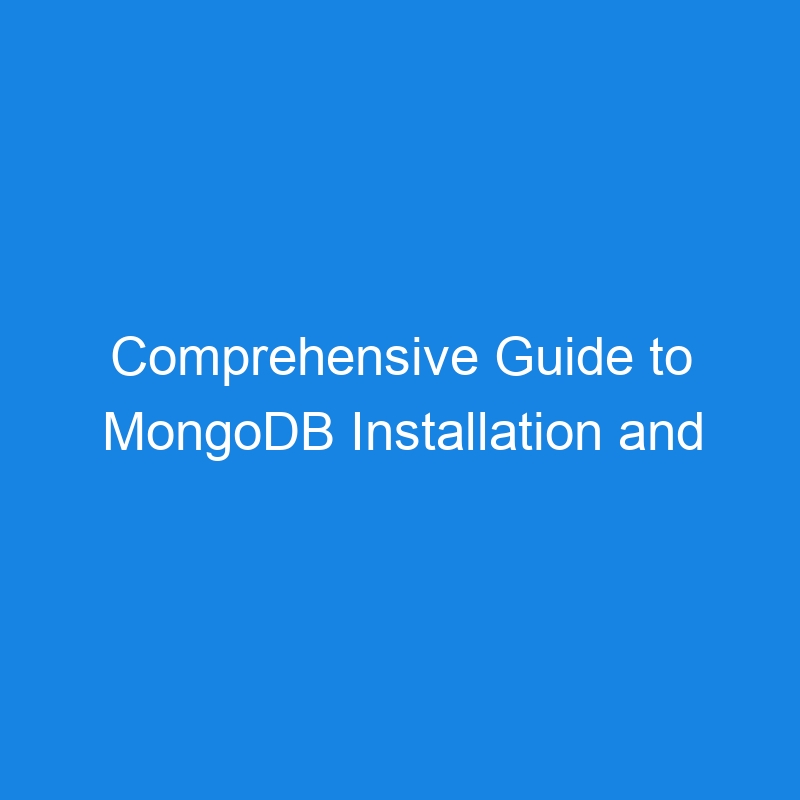Installation and Configuration in MongoDB
Here’s a detailed description of each topic:
1. How do you install MongoDB on Windows/Linux/Mac?
Windows:
- Download the MongoDB Community Server MSI installer from the official MongoDB website.
- Run the installer and follow the setup wizard, selecting the complete installation and optional MongoDB Compass.
- Configure MongoDB as a Windows service (optional).
- Add the MongoDB binaries directory to your system’s PATH for command-line use.
Linux:
- Import the MongoDB public GPG key.
- Add the MongoDB repository to your package manager.
- Update the package index and install MongoDB using your distribution’s package manager (e.g.,
aptfor Ubuntu,yumfor CentOS). - Start the MongoDB service with
sudo systemctl start mongod.
Mac:
- Use Homebrew to install MongoDB. Run
brew tap mongodb/brewand thenbrew install mongodb-community@<version>. - Start MongoDB with
brew services start mongodb/brew/mongodb-community.
2. What is the purpose of the mongod command?
- The
mongodcommand is used to start the MongoDB server (daemon). - It initializes the database engine and begins listening for client connections on the default port (27017).
- Common options:
-
--dbpath: Specifies the directory where MongoDB stores data. -
--logpath: Specifies the log file location. -
--port: Sets a custom port for the server.
-
Example:
mongod --dbpath /data/db --logpath /var/log/mongodb/mongod.log
3. Explain the configuration file in MongoDB.
- MongoDB uses a YAML-formatted configuration file (
mongod.conf) to define server behavior. - Common configuration options include:
-
Storage: Path for data files (
storage.dbPath). -
Networking: Port number and bind IP address (
net.port,net.bindIp). -
Security: Authentication and access control settings (
security.authorization). -
Replication: Replica set settings (
replication.replSetName).
-
Storage: Path for data files (
Example mongod.conf:
storage:
dbPath: /var/lib/mongo
net:
port: 27017
bindIp: 127.0.0.1
security:
authorization: enabled
Run MongoDB with this file:
mongod --config /etc/mongod.conf
4. What are the default ports for MongoDB?
- 27017: Default port for MongoDB client connections.
- 27018: Default port for MongoDB when running as a replica set member.
- 27019: Default port for MongoDB when used in a sharded cluster.
5. How do you secure a MongoDB instance?
-
Enable Authentication:
- Add users with appropriate roles using
db.createUser(). - Enable authentication in the configuration file:
security: authorization: enabled - Add users with appropriate roles using
-
Bind IP Address:
- Restrict MongoDB to listen only on specific IPs (e.g.,
127.0.0.1).
- Restrict MongoDB to listen only on specific IPs (e.g.,
-
Use Firewalls:
- Block unauthorized access to MongoDB ports.
-
Encrypt Data:
- Use TLS/SSL to encrypt communication.
- Enable data-at-rest encryption for sensitive information.
-
Update Regularly:
- Keep MongoDB up to date to protect against known vulnerabilities.
6. What is a replica set in MongoDB?
- A replica set is a group of MongoDB servers that maintain the same data, providing redundancy and high availability.
- Components:
- Primary Node: Handles write operations.
- Secondary Nodes: Replicate data from the primary node and can serve read queries.
- Arbiter: A lightweight member used to break ties during elections.
To initiate a replica set:
- Start MongoDB with
--replSetoption. - Configure the replica set:
rs.initiate({
_id: "myReplicaSet",
members: [
{ _id: 0, host: "localhost:27017" },
{ _id: 1, host: "localhost:27018" },
{ _id: 2, host: "localhost:27019" }
]
});
7. How can you run MongoDB in a Docker container?
- Pull MongoDB Image:
docker pull mongo
- Run a MongoDB Container:
docker run --name mongodb -d -p 27017:27017 -v /data/db:/data/db mongo
- Set Environment Variables (e.g., authentication):
docker run --name mongodb -d -p 27017:27017 -e MONGO_INITDB_ROOT_USERNAME=admin -e MONGO_INITDB_ROOT_PASSWORD=password mongo
8. Explain MongoDB Compass and its use cases.
- MongoDB Compass is a graphical user interface (GUI) for MongoDB.
- It provides a visual way to interact with MongoDB without using the command line.
Use Cases:
- Visual Query Building: Create and run queries without writing raw code.
- Schema Analysis: Understand and analyze the structure of your collections.
- Performance Monitoring: View query execution times and database performance metrics.
- Data Management: Easily add, edit, and delete documents.
9. How do you take a backup of a MongoDB database?
-
Using
mongodump:- Exports the database in BSON format.
mongodump --db myDatabase --out /backup/directory
-
File System Snapshot:
- Create a snapshot of the data directory if the database is inactive.
-
Automated Backups:
- Use third-party tools or MongoDB Ops Manager/Atlas for scheduled backups.
10. How can you restore data in MongoDB?
-
Using
mongorestore:- Imports BSON data back into MongoDB.
mongorestore --db myDatabase /backup/directory/myDatabase
-
Restore from Snapshot:
- Replace the database files with the snapshot.
-
For Sharded Clusters:
- Use backups taken from the
mongosinstance for consistency.
- Use backups taken from the
These points collectively cover the essential aspects of installing, configuring, and managing MongoDB.
Hi, I’m Abhay Singh Kathayat!
I am a full-stack developer with expertise in both front-end and back-end technologies. I work with a variety of programming languages and frameworks to build efficient, scalable, and user-friendly applications.
Feel free to reach out to me at my business email: kaashshorts28@gmail.com.
